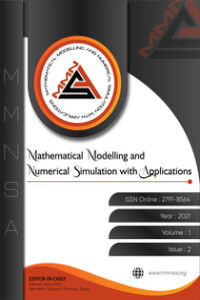Research Article
Year 2021,
Volume: 1 Issue: 2, 56 - 66, 30.12.2021
Abstract
In this paper, we consider a modified SIR (susceptible-infected-recovered/removed) model that describes the evolution in time of the infectious disease caused by Sars-Cov-2 (Severe Acute Respiratory Syndrome-Coronavirus-2). We take into consideration that this disease can be both symptomatic and asymptomatic. By formulating a suitable mathematical model via a system of ordinary differential equations (ODEs), we investigate how the vaccination rate and the fraction of avoided contacts affect the population dynamics.
References
- https://www.who.int/health-topics/coronavirus.
- Bernoulli, D., Blower, S. An attempt at a new analysis of the mortality caused by smallpox and of the advantages of inoculation to prevent it. Reviews in medical virology,14(5), 275-288, (2004).
- Rahimi, I., Chen, F. and Gandomi, A.H. A review on COVID-19 forecasting models. Neural Computing and Applications, 1-11, (2021).
- Akgül, A., Ahmed, N., Raza, A., et al. New applications related to Covid-19.Results in Physics,20, 103663, (2021).
- Farman, M., Akgül, A., Ahmad, A., Baleanu, D., Saleem, M.U. Dynamical Transmission of Coronavirus Model with Analysis and Simulation. CMES-Computer Modeling in Engineering and Sciences, 127(2), 753–769, (2021).
- Amico, E., Bulai, I.M. How political choices shaped Covid connectivity: the Italian case study, Plos One, (2021).
- Zeb, A., Alzahrani, E., Erturk, V.S., Zaman, G. Mathematical model for Coronavirus Disease 2019 (COVID-19) Containing Isolation Class. BioMed Research International, (2020).
- Zhang, Z., Zeb, A., Hussain, S., Alzahrani, E. Dynamics of COVID-19 mathematical model with stochastic perturbation. Advances in Difference Equations, 2020(1), 1-12, (2020).
- Naik, P.A., Yavuz, M., Qureshi, S., Zu, J. & Townley, S. Modeling and analysis of COVID-19 epidemics with treatment in fractional derivatives using real data from Pakistan. The European Physical Journal Plus, 135(10), 1-42, (2020).
- Zhang, Z., Zeb, A., Egbelowo, O.F., Erturk, V.S. Dynamics of a fractional order mathematical model for COVID-19 epidemic. Advances in Difference Equations, 2020(1), 1-16, (2020).
- Özköse, F., Yavuz, M. Investigation of interactions between COVID-19 and diabetes with hereditary traits using real data: A case study in Turkey. Computers in Biology and Medicine, 105044, (2021).
- Nazir, G., Zeb, A., Shah, K., Saeed, T., Khan, R.A. & Khan, S.I.U. Study of COVID-19 mathematical model of fractional order via modified Euler method. Alexandria Engineering Journal, 60(6), 5287-5296, (2021).
- Bushnaq, S., Saeed, T., Torres, D.F.M., Zeb, A. Control of COVID-19 dynamics through a fractional-order model. Alexandria Engineering Journal, 60(4), 3587-3592, (2021).
- Yavuz, M., Coşar, F.Ö, Günay, F., Özdemir, F.N. A new mathematical modeling of the COVID-19 pandemic including the vaccination campaign. Open Journal of Modelling and Simulation, 9(3), 299-321, (2021).
- Zhang, Z., Zeb, A., Alzahrani, E. & Iqbal, S. Crowding effects on the dynamics of COVID-19 mathematical model. Advances in Difference Equations, 2020(1), 1-13, (2020).
- Li, X.P., Al Bayatti, H., Din, A. & Zeb, A. A vigorous study of fractional order COVID-19 model via ABC derivatives. Results in Physics, 29, 104737, (2021).
- Guan, J., Wei, Y., Zhao, Y., Chen, F. Modeling the transmission dynamics of COVID-19 epidemic: a systematic review. Journal of Biomedical Research, 34(6), 422-430, (2020).
- Atangana, A., Araz, S.İ. Mathematical model of COVID-19 spread in Turkey and South Africa: theory, methods, and applications. Advances in Difference Equations, 2020(1), 1-89, (2020).
- Amaro, J.E., Dudouet, J., Orce, J.N. Global analysis of the COVID-19 pandemic using simple epidemiological models. Applied Mathematical Modelling, 90, 995-1008, (2021).
- Buonomo, B., Della Marca, R. Effects of information-induced behavioural changes during the COVID-19 lockdowns: the case of Italy. Royal Society Open Science, 7(10), 201635, (2020).
- Zhu, H., Li, Y., Jin, X., Huang, J., Liu, X., Qian, Y., Tan, J. Transmission dynamics and control methodology of COVID-19: A modeling study. Applied Mathematical Modelling, 89(2), 1983-1998, (2021).
- Pellis, L., et al. & University of Manchester COVID-19 Modelling Group. Challenges in control of Covid-19: short doubling time and long delay to effect of interventions. Philosophical Transactions of the Royal Society B, 376(1829), 20200264, (2021).
- Sun, D., Duan, L., Xiong, J. & Wang, D. Modeling and forecasting the spread tendency of the COVID-19 in China. Advances in Difference Equations, 2020(1), 1-16, (2020).
- Giordano, G., Blanchini, F., Bruno, R., Colaneri, P., Di Filippo, A., Di Matteo, A. & Colaneri, M. Modelling the COVID-19 epidemic and implementation of population-wide interventions in Italy. Nature medicine, 26(6), 855–860, (2020).
- Pedersen, M.G., Meneghini, M. Data-driven estimation of change points reveals correlation between face mask use and accelerated curtailing of the first wave of the COVID-19 epidemic in Italy. Infectious Diseases, 53(4), 243-251, (2021).
- Viguerie, A., et al. Simulating the spread of COVID-19 via a spatially-resolved susceptible–exposed–infected–recovered–deceased (SEIRD) model with heterogeneous diffusion. Applied Mathematics Letters, 111, 106617, (2021).
- Ferguson, N., et al. Report 9: Impact of non-pharmaceutical interventions (NPIs) to reduce COVID19 mortality and healthcare demand. Imperial College London, (2020).
- Chowdhury, R., Heng, K., Shawon, M.S.R., Goh, G., Okonofua, D., Ochoa-Rosales, C., ... & Franco, O.H. Dynamic interventions to control COVID-19 pandemic: a multivariate prediction modelling study comparing 16 worldwide countries. European journal of epidemiology, 35(5), 389-399, (2020).
- Jiao, J., Liu, Z., Cai, S. Dynamics of an SEIR model with infectivity in incubation period and homestead-isolation on the susceptible. Applied Mathematics Letters, 107, 106442, (2020).
- Bai, Y., Yao, L., Wei, T., Tian, F., Jin, D.Y., Chen, L. & Wang, M. Presumed Asymptomatic Carrier Transmission of COVID-19. JAMA, 323(14), 1406-1407, (2020).
- Sakurai, A., Sasaki, T., Kato, S., Hayashi, M., Tsuzuki, S.I., Ishihara, T., et al. Natural History of Asymptomatic SARS-CoV-2 Infection. N Engl J Med, 383(9), 885-886, (2020).
- Moore, S., Hill, E.M., Tildesley, M.J., Dyson, L., Keeling, M.J. Vaccination and non-pharmaceutical interventions for COVID-19: a mathematical modelling study. The Lancet Infectious Diseases, 21(6), 793-802, (2021).
- Aniţa, S., Banerjee, M., Ghosh, S., Volpert, V. Vaccination in a two-group epidemic model. Applied Mathematics Letters, 119, 107197, (2021).
- Estrada, E. COVID-19 and SARS-CoV-2: Modeling the present, looking at the future. Physics Reports, 869, 1-51, (2020).
- Bulai, I.M. Modeling Covid-19 Considering Asymptomatic Cases and Avoided Contacts. Chapter in Trends in Biomathematics: Chaos and Control in Epidemics, Ecosystems, and Cells, Springer, (2021).
- https://www.istat.it/storage/rapporto-annuale/2018/Rapportoannuale2018.pdf.
- https://raw.githubusercontent.com/pcm-dpc/COVID-19/master/dati-json/dpc-covid19-ita-andamento-nazionale.json
- Pedersen, M.G., Meneghini, M. Quantifying undetected COVID-19 cases and effects of containment measures in Italy, (2020).
- National Institute of Infectious Diseases Japan. Field Briefing: Diamond Princess COVID-19 Cases, 20 Feb Update. Last accessed March 12, 2020. Available from: https://www.niid.go.jp/niid/en/2019-ncov-e/9417-covid-dp-fe-02.html.
- O. Diekmann, J.A.P. Heesterbeek, J.A.J. Metz. On the definition and the computation of the basic reproduction ratio R0 in models for infectious diseases in heterogeneous populations. Journal of mathematical biology, 28, 365-382, (1990).
- P. Van den Driessche, J. Watmough. Reproduction numbers and sub-threshold endemic equilibria for compartmental models of disease transmission. Math Biosci, 180(1), 29–48, (2002).
Year 2021,
Volume: 1 Issue: 2, 56 - 66, 30.12.2021
Abstract
References
- https://www.who.int/health-topics/coronavirus.
- Bernoulli, D., Blower, S. An attempt at a new analysis of the mortality caused by smallpox and of the advantages of inoculation to prevent it. Reviews in medical virology,14(5), 275-288, (2004).
- Rahimi, I., Chen, F. and Gandomi, A.H. A review on COVID-19 forecasting models. Neural Computing and Applications, 1-11, (2021).
- Akgül, A., Ahmed, N., Raza, A., et al. New applications related to Covid-19.Results in Physics,20, 103663, (2021).
- Farman, M., Akgül, A., Ahmad, A., Baleanu, D., Saleem, M.U. Dynamical Transmission of Coronavirus Model with Analysis and Simulation. CMES-Computer Modeling in Engineering and Sciences, 127(2), 753–769, (2021).
- Amico, E., Bulai, I.M. How political choices shaped Covid connectivity: the Italian case study, Plos One, (2021).
- Zeb, A., Alzahrani, E., Erturk, V.S., Zaman, G. Mathematical model for Coronavirus Disease 2019 (COVID-19) Containing Isolation Class. BioMed Research International, (2020).
- Zhang, Z., Zeb, A., Hussain, S., Alzahrani, E. Dynamics of COVID-19 mathematical model with stochastic perturbation. Advances in Difference Equations, 2020(1), 1-12, (2020).
- Naik, P.A., Yavuz, M., Qureshi, S., Zu, J. & Townley, S. Modeling and analysis of COVID-19 epidemics with treatment in fractional derivatives using real data from Pakistan. The European Physical Journal Plus, 135(10), 1-42, (2020).
- Zhang, Z., Zeb, A., Egbelowo, O.F., Erturk, V.S. Dynamics of a fractional order mathematical model for COVID-19 epidemic. Advances in Difference Equations, 2020(1), 1-16, (2020).
- Özköse, F., Yavuz, M. Investigation of interactions between COVID-19 and diabetes with hereditary traits using real data: A case study in Turkey. Computers in Biology and Medicine, 105044, (2021).
- Nazir, G., Zeb, A., Shah, K., Saeed, T., Khan, R.A. & Khan, S.I.U. Study of COVID-19 mathematical model of fractional order via modified Euler method. Alexandria Engineering Journal, 60(6), 5287-5296, (2021).
- Bushnaq, S., Saeed, T., Torres, D.F.M., Zeb, A. Control of COVID-19 dynamics through a fractional-order model. Alexandria Engineering Journal, 60(4), 3587-3592, (2021).
- Yavuz, M., Coşar, F.Ö, Günay, F., Özdemir, F.N. A new mathematical modeling of the COVID-19 pandemic including the vaccination campaign. Open Journal of Modelling and Simulation, 9(3), 299-321, (2021).
- Zhang, Z., Zeb, A., Alzahrani, E. & Iqbal, S. Crowding effects on the dynamics of COVID-19 mathematical model. Advances in Difference Equations, 2020(1), 1-13, (2020).
- Li, X.P., Al Bayatti, H., Din, A. & Zeb, A. A vigorous study of fractional order COVID-19 model via ABC derivatives. Results in Physics, 29, 104737, (2021).
- Guan, J., Wei, Y., Zhao, Y., Chen, F. Modeling the transmission dynamics of COVID-19 epidemic: a systematic review. Journal of Biomedical Research, 34(6), 422-430, (2020).
- Atangana, A., Araz, S.İ. Mathematical model of COVID-19 spread in Turkey and South Africa: theory, methods, and applications. Advances in Difference Equations, 2020(1), 1-89, (2020).
- Amaro, J.E., Dudouet, J., Orce, J.N. Global analysis of the COVID-19 pandemic using simple epidemiological models. Applied Mathematical Modelling, 90, 995-1008, (2021).
- Buonomo, B., Della Marca, R. Effects of information-induced behavioural changes during the COVID-19 lockdowns: the case of Italy. Royal Society Open Science, 7(10), 201635, (2020).
- Zhu, H., Li, Y., Jin, X., Huang, J., Liu, X., Qian, Y., Tan, J. Transmission dynamics and control methodology of COVID-19: A modeling study. Applied Mathematical Modelling, 89(2), 1983-1998, (2021).
- Pellis, L., et al. & University of Manchester COVID-19 Modelling Group. Challenges in control of Covid-19: short doubling time and long delay to effect of interventions. Philosophical Transactions of the Royal Society B, 376(1829), 20200264, (2021).
- Sun, D., Duan, L., Xiong, J. & Wang, D. Modeling and forecasting the spread tendency of the COVID-19 in China. Advances in Difference Equations, 2020(1), 1-16, (2020).
- Giordano, G., Blanchini, F., Bruno, R., Colaneri, P., Di Filippo, A., Di Matteo, A. & Colaneri, M. Modelling the COVID-19 epidemic and implementation of population-wide interventions in Italy. Nature medicine, 26(6), 855–860, (2020).
- Pedersen, M.G., Meneghini, M. Data-driven estimation of change points reveals correlation between face mask use and accelerated curtailing of the first wave of the COVID-19 epidemic in Italy. Infectious Diseases, 53(4), 243-251, (2021).
- Viguerie, A., et al. Simulating the spread of COVID-19 via a spatially-resolved susceptible–exposed–infected–recovered–deceased (SEIRD) model with heterogeneous diffusion. Applied Mathematics Letters, 111, 106617, (2021).
- Ferguson, N., et al. Report 9: Impact of non-pharmaceutical interventions (NPIs) to reduce COVID19 mortality and healthcare demand. Imperial College London, (2020).
- Chowdhury, R., Heng, K., Shawon, M.S.R., Goh, G., Okonofua, D., Ochoa-Rosales, C., ... & Franco, O.H. Dynamic interventions to control COVID-19 pandemic: a multivariate prediction modelling study comparing 16 worldwide countries. European journal of epidemiology, 35(5), 389-399, (2020).
- Jiao, J., Liu, Z., Cai, S. Dynamics of an SEIR model with infectivity in incubation period and homestead-isolation on the susceptible. Applied Mathematics Letters, 107, 106442, (2020).
- Bai, Y., Yao, L., Wei, T., Tian, F., Jin, D.Y., Chen, L. & Wang, M. Presumed Asymptomatic Carrier Transmission of COVID-19. JAMA, 323(14), 1406-1407, (2020).
- Sakurai, A., Sasaki, T., Kato, S., Hayashi, M., Tsuzuki, S.I., Ishihara, T., et al. Natural History of Asymptomatic SARS-CoV-2 Infection. N Engl J Med, 383(9), 885-886, (2020).
- Moore, S., Hill, E.M., Tildesley, M.J., Dyson, L., Keeling, M.J. Vaccination and non-pharmaceutical interventions for COVID-19: a mathematical modelling study. The Lancet Infectious Diseases, 21(6), 793-802, (2021).
- Aniţa, S., Banerjee, M., Ghosh, S., Volpert, V. Vaccination in a two-group epidemic model. Applied Mathematics Letters, 119, 107197, (2021).
- Estrada, E. COVID-19 and SARS-CoV-2: Modeling the present, looking at the future. Physics Reports, 869, 1-51, (2020).
- Bulai, I.M. Modeling Covid-19 Considering Asymptomatic Cases and Avoided Contacts. Chapter in Trends in Biomathematics: Chaos and Control in Epidemics, Ecosystems, and Cells, Springer, (2021).
- https://www.istat.it/storage/rapporto-annuale/2018/Rapportoannuale2018.pdf.
- https://raw.githubusercontent.com/pcm-dpc/COVID-19/master/dati-json/dpc-covid19-ita-andamento-nazionale.json
- Pedersen, M.G., Meneghini, M. Quantifying undetected COVID-19 cases and effects of containment measures in Italy, (2020).
- National Institute of Infectious Diseases Japan. Field Briefing: Diamond Princess COVID-19 Cases, 20 Feb Update. Last accessed March 12, 2020. Available from: https://www.niid.go.jp/niid/en/2019-ncov-e/9417-covid-dp-fe-02.html.
- O. Diekmann, J.A.P. Heesterbeek, J.A.J. Metz. On the definition and the computation of the basic reproduction ratio R0 in models for infectious diseases in heterogeneous populations. Journal of mathematical biology, 28, 365-382, (1990).
- P. Van den Driessche, J. Watmough. Reproduction numbers and sub-threshold endemic equilibria for compartmental models of disease transmission. Math Biosci, 180(1), 29–48, (2002).
There are 41 citations in total.
Details
| Primary Language | English |
|---|---|
| Subjects | Bioinformatics and Computational Biology, Applied Mathematics |
| Journal Section | Research Articles |
| Authors | |
| Publication Date | December 30, 2021 |
| Submission Date | October 13, 2021 |
| Published in Issue | Year 2021 Volume: 1 Issue: 2 |
Cited By
Modeling COVID-19 and heart disease interactions through Caputo fractional derivative: memory trace analysis
Modeling Earth Systems and Environment
https://doi.org/10.1007/s40808-024-02133-w
Optimizing tuberculosis control: a comprehensive simulation of integrated interventions using a mathematical model
Mathematical Modelling and Numerical Simulation with Applications
https://doi.org/10.53391/mmnsa.1461011
Threshold dynamics of a stochastic SIHR epidemic model of COVID-19 with general population-size dependent contact rate
Mathematical Biosciences and Engineering
https://doi.org/10.3934/mbe.2022195
Atangana–Baleanu derivative-based fractional model of COVID-19 dynamics in Ethiopia
Applied Mathematics in Science and Engineering
https://doi.org/10.1080/27690911.2022.2121823
A stochastic mussel-algae model under regime switching
Mathematical Biosciences and Engineering
https://doi.org/10.3934/mbe.2022224
Fractional Order Modeling of Predicting COVID-19 with Isolation and Vaccination Strategies in Morocco
Computer Modeling in Engineering & Sciences
https://doi.org/10.32604/cmes.2023.025033
A new mathematical model for tuberculosis epidemic under the consciousness effect
Mathematical Modelling and Control
https://doi.org/10.3934/mmc.2023009
Modelling and analysis of fractional-order vaccination model for control of COVID-19 outbreak using real data
Mathematical Biosciences and Engineering
https://doi.org/10.3934/mbe.2023010
A SARS-CoV-2 Fractional-Order Mathematical Model via the Modified Euler Method
Mathematical and Computational Applications
https://doi.org/10.3390/mca27050082
Stationary distribution and extinction of a stochastic influenza virus model with disease resistance
Mathematical Biosciences and Engineering
https://doi.org/10.3934/mbe.2022424
Mathematical modeling of corona virus (COVID-19) and stability analysis
Computer Methods in Biomechanics and Biomedical Engineering
https://doi.org/10.1080/10255842.2022.2109020
Analysis of mobility based COVID-19 epidemic model using Federated Multitask Learning
Mathematical Biosciences and Engineering
https://doi.org/10.3934/mbe.2022466
Dynamics of optimal harvesting in an Ammensal-Adversarial interaction
Alexandria Engineering Journal
https://doi.org/10.1016/j.aej.2022.06.019
Math Model Numer Simul Appl - 2025



The published articles in MMNSA are licensed under a Creative Commons Attribution 4.0 International License
The published articles in MMNSA are licensed under a Creative Commons Attribution 4.0 International License


